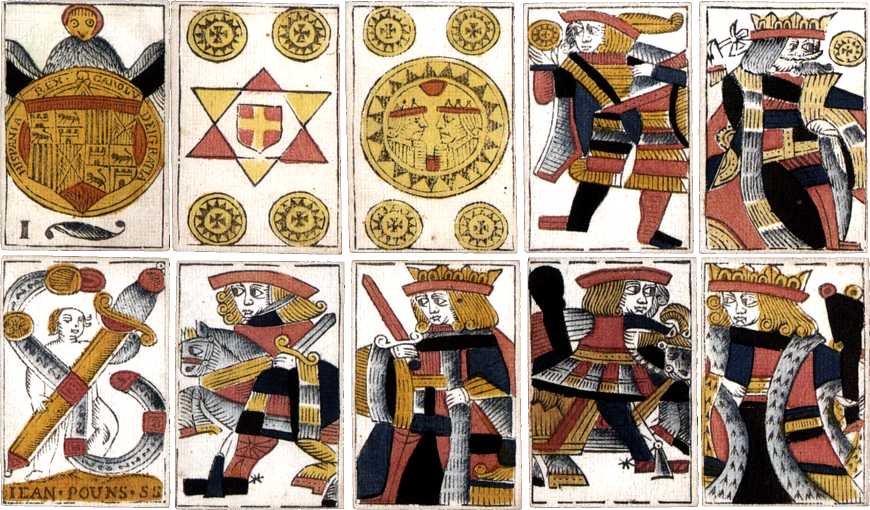Archaic Franco-Spanish pattern
Archaic Franco-Spanish pattern by Guillaume & Jean Grossard (Bordeaux).
These XVI century Spanish-suited cards by Grossard represent an archaic pattern which was widely produced in France as well as Spain. Many early examples come from France.¹ In these early days card designs were being exported via trade routes and copied between different areas.
The woodcut outlines and stencil colouring in this example are clearly defined. The ace of coins features a Spanish coat-of-arms with the inscription “Histania Rex Carolv Dei Gratia”, and the name I. Grossard appears in a scroll. The eagle looks more like an owl. The king holds a small axe and the cavalier of coins is seen from behind. The two of swords has a partly illegible inscription “Fecha en Bordaux” probably reflecting the regional dialect of the time. The ace of swords, with its ornamental strap and characteristically accompanied by a naked person, has the name Guillaume Grossard, suggesting that these cards come from two incomplete packs. The ‘sota’ of cups displays a heraldic lion. There are no line-breaks, or ‘pintas’, as these didn't appear until the mid-eighteenth century. Three of the jacks have additional decorative flowers.



Above: Franco-Spanish pattern by Jean Grossard & Guillaume Grossard, Bordeaux, 16th century. Woodblock & stencil, mixed packs. Source gallica.bnf.fr / BnF.
Cards with similar designs were produced by Jean Pouns S.S. (possibly of San Sebastian). The Five of Coins shows the portraits of the Catholic monarchs, whilst the Four of Coins has a six-pointed star with a shield in the centre. The Ace of Swords has a small person in the background.

Above: cards from a woodblock and stencilled Spanish-suited pack, of similar design, made by Jean Pouns S.S. (possibly of San Sebastian), c.1680.
The Franco-Spanish pattern is known from before the Spanish National pattern emerged, which was an entirely new design probably originating in 17th century Catalonia. Prior to all this, the so-called ‘dragon cards’ were used in Spain, also in Italy, Sicily and Malta, as well as several earlier Gothic Spanish-suited patterns. Earlier still, of course, cards first arrived from the Islamic world to Spain and Italy in c.1370.
Notes and References
¹ Examples include packs by Diego del Campo (Toledo, c.1540), Pierre Pepin (Seville) and Phelippe Ayet (Valencia, 1574), François Gaben, Jehan Person, Jean Pouns, Guillaume Grossard (Bordeaux) and Jehan Volay. Examples made in Spain were often by French immigrant card makers. Examples from Toledo dated 1584 are also known.
Bibliothèque nationale de France: Cartes d'un jeu au portrait espagnol►
Denning, Trevor: The Playing-Cards of Spain, Cygnus Arts, London, 1996
Mann, Sylvia: All Cards on the Table, Jonas Verlag/Deutsches Spielkarten-Museum, Leinfelden-Echterdingen, 1990

By Simon Wintle
Member since February 01, 1996
I am the founder of The World of Playing Cards (est. 1996), a website dedicated to the history, artistry and cultural significance of playing cards and tarot. Over the years I have researched various areas of the subject, acquired and traded collections and contributed as a committee member of the IPCS and graphics editor of The Playing-Card journal. Having lived in Chile, England, Wales, and now Spain, these experiences have shaped my work and passion for playing cards. Amongst my achievements is producing a limited-edition replica of a 17th-century English pack using woodblocks and stencils—a labour of love. Today, the World of Playing Cards is a global collaborative project, with my son Adam serving as the technical driving force behind its development. His innovative efforts have helped shape the site into the thriving hub it is today. You are warmly invited to become a contributor and share your enthusiasm.
Related Articles

Jeu Buffon
Illustrations of different birds from works by Buffon to celebrate the bicentenary of his death.

Pathé Marconi
Special promotion pack for French record company Pathé Marconi.

Pierre Varangot
Tracing the origins, legality and legacy of Pierre Varangot’s San Sebastián deck.

Archaic Spanish-suited pattern from Bayonne
Archaic Franco-Spanish pattern from Bayonne by a manufacturer with the initals M.V.

Caisse Mutuelle d'Assurance et de Prevoyance
Insurance propaganda pack for Caisse Mutuelle d'Assurance et de Prevoyance with humorous artwork by ...

Jeu Révolutionnaire
Court cards and aces from a French Revolutionary pack by Pinaut, Paris, c.1794.

French Revolutionary cards by Pinaut
Seven cards from a French Revolutionary pack by Pinaut featuring characters from classical antiquity...

Tarot de las Coscojas
Historical playing card design, tarot symbolism and an almost psychedelic medieval surrealism.

Tarot de Valverde de la Vera
A series of 24 surrealist engravings by Mexican artist Claudio Favier in which archetypal Tarot alle...

Never Mind the Belote
Limited edition Belote pack with designs by a collective of 24 street artists.

Sannois dans les étoiles
Celebrities and buildings associated with Sannois, a commune in the suburbs of Paris.

Le Globe Céleste
Views and plans of five international exhibitions held in Paris between 1855 and 1900.

Baraja de Juan Martín Zamorano
Deck inspired by El Pendón de los Zamorano, a military pennant dating from 1501, published by Priego...

Le Journal de Mickey
Perforated sheet of cards with Disney characters issued with the magazine Le Journal de Mickey.

Tarot hiéroglyphique égyptien
The design of the cards draws inspiration from various religious and philosophical traditions merged...

Heráldica Castanyer No. 16
Strange variant of international pattern cards for poker or bridge.
Most Popular
Our top articles from the past 28 days

